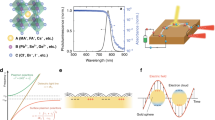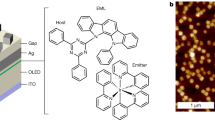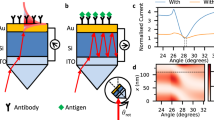Abstract
Surface plasmons are hybrid modes of longitudinal electron oscillations and light fields at the interface of a metal and a dielectric1,2. Driven by advances in nanofabrication, imaging and numerical methods3,4, a wide range of plasmonic elements such as waveguides5,6, Bragg mirrors7, beamsplitters8, optical modulators9 and surface plasmon detectors10 have recently been reported. For introducing dynamic functionality to plasmonics, the rapidly growing field of organic optoelectronics11 holds strong promise due to its ease of fabrication and integration opportunities. Here, we introduce an electrically switchable surface plasmon source based on an organic light‐emitting diode. The source provides a freely propagating surface plasmon beam and is potentially useful for organic integrated photonic circuits and sensing applications. Furthermore, the demonstration of controlled coupling of surface plasmons and excitons in organic materials could prove useful for the fabrication of improved organic light-emitting diodes and organic photovoltaic devices.
This is a preview of subscription content, access via your institution
Access options
Subscribe to this journal
Receive 12 print issues and online access
$209.00 per year
only $17.42 per issue
Buy this article
- Purchase on Springer Link
- Instant access to full article PDF
Prices may be subject to local taxes which are calculated during checkout


Similar content being viewed by others
References
Otto, A. Excitation of nonradiative surface plasma waves in silver by the method of frustrated total reflection. Zeit. für Physik 216, 398–410 (1968).
Raether, H. Surface Plasmons on Smooth and Rough Surfaces and on Gratings. Springer Tracts in Mod. Phys. 111, 1–133 (Springer, 1988).
Barnes, W. L., Dereux, A. & Ebbesen, T. W. Surface plasmon sub-wavelength optics. Nature 424, 824–830 (2003).
Lal, S., Link, S. & Halas, N. J. Nano-optics from sensing to waveguiding. Nature Photon. 1, 641–648 (2007).
Berini, P. Plasmon-polariton waves guided by thin lossy metal films of finite width: Bound modes of symmetric structures. Phys. Rev. B 61, 10484–10503 (2000).
Weeber, J. C. et al. Near-field observation of surface plasmon polariton propagation on thin metal stripes. Phys. Rev. B 64, 045411 (2001).
Ditlbacher, H., Krenn, J. R., Schider, G., Leitner, A. & Aussenegg, F. R. Two-dimensional optics with surface plasmon polaritons. Appl. Phys. Lett. 81, 1762–1764 (2002).
Drezet, A. et al. Plasmonic crystal demultiplexer and multiports. Nano Lett. 7, 1697–1700 (2007).
Pacifici, D., Lezec, H. J. & Atwater, H. A. All-optical modulation by plasmonic excitation of CdSe quantum dots. Nature Photon. 1, 402–406 (2007).
Ditlbacher, H. et al. Organic diodes as monolithically integrated surface plasmon polariton detectors. Appl. Phys. Lett. 89, 161101 (2006).
Forrest, S. R. The path to ubiquitous and low-cost organic electronic appliances on plastic. Nature 428, 911–918 (2004).
Weber, W. H. & Eagen, C. F. Energy transfer from an excited dye molecule to the surface plasmons of an adjacent metal. Opt. Lett. 4, 236–238 (1979).
Barnes, W. L. Fluorescence near interfaces: the role of photonic mode density. J. Mod. Opt. 45, 661–699 (1998).
Okamoto, K. et al. Surface-plasmon‐enhanced light emitters based on InGaN quantum wells. Nature Mater. 3, 601–605 (2004).
Smith, L. H., Wasey, J. A. E. & Barnes, W. L. Light outcoupling efficiency of top-emitting organic light-emitting diodes. Appl. Phys. Lett. 84, 2986–2988 (2004).
Hobson, P. A., Wedge, S., Wasey, J. A. E., Sage, I. & Barnes, W. L. Surface plasmon mediated emission from organic light emitting diodes. Adv. Mater. 14, 1393–1396 (2002).
Baldo, M. A., Thompson, M. E. & Forrest, S. R. Phosphorescent materials for application to organic light emitting devices. Pure Appl. Chem. 71, 2095–2106 (1999).
Baldo, M. A. et al. Highly efficient phosphorescent emission from organic electroluminescent devices. Nature 395, 151–154 (1998).
Jabbour, G. E., Wang, J.-F. & Peyghambarian, N. High-efficiency organic electrophosphorescent devices through balance of charge injection. Appl. Phys. Lett. 80, 2026–2028 (2002).
Koller, D. M. et al. Surface plasmon coupled electroluminescent emission. Appl. Phys. Lett. 92, 103304 (2008).
Koller, D. M. et al. Three-dimensional SU-8 submicrometer structuring by electron beam lithography. Microelectron. Eng. 85, 1639–1641 (2008).
Hecht, B., Bielefeldt, H., Novotny, L., Inouye, Y. & Pohl, D. W. Local excitation, scattering, and interference of surface plasmons. Phys. Rev. Lett. 77, 1889–1892 (1996).
Drezet, A. et al. How to erase surface plasmon fringes. Appl. Phys. Lett. 89, 091117 (2006).
Bouhelier, A. & Wiederrecht, G. P. Surface plasmon rainbow jets. Opt. Lett. 30, 884–886 (2005).
Fukuda, T., Okada, T., Wei, B., Ichikawa, M. & Taniguchi, Y. Influence of carrier-injection efficiency on modulation rate of organic light source. Opt. Lett. 32, 1905–1907 (2007).
Palik, E. D. Handbook of Optical Constants of Solids(Academic, Orlando, FL, 1985).
Hobson, P. A., Wasey, J. A. E., Sage, I. & Barnes, W. L. The role of surface plasmons in organic light-emitting diodes. IEEE J. Sel. Top. Quantum Electron. 8, 378–386 (2002).
Chan, J. et al. Device optimization of tris-aluminum (Alq3) based bilayer organic light emitting diode structures. Smart Mater. Struct. 15, 92–98 (2006).
Yamamoto, H., Oyamada, T., Sasabe, H. & Adachi, C. Amplified spontaneous emission under optical pumping from an organic semiconductor laser structure equipped with transparent carrier injection electrodes. Appl. Phys. Lett. 84, 1401–1403 (2004).
Acknowledgements
We thank G. Jakopic for fruitful discussions. NAWI Graz, Graz Advanced School of Science (GASS) and the project cluster ISOTEC (N702 SENSPHYS, N704 POLYSENS) of the national Austrian NANO initiative are acknowledged for funding this work.
Author information
Authors and Affiliations
Contributions
J.R.K., E.J.W.L. and D.M.K. conceived and designed the experiments. D.M.K. performed the experiments. D.M.K., H.D., F.R.A., A.L. and F.R. analysed the data. N.G., A.H. and E.J.W.L. contributed materials and analysis tools. D.M.K. and J.R.K. wrote the paper.
Corresponding author
Rights and permissions
About this article
Cite this article
Koller, D., Hohenau, A., Ditlbacher, H. et al. Organic plasmon-emitting diode. Nature Photon 2, 684–687 (2008). https://doi.org/10.1038/nphoton.2008.200
Received:
Accepted:
Published:
Issue Date:
DOI: https://doi.org/10.1038/nphoton.2008.200
This article is cited by
-
Highly-efficient electrically-driven localized surface plasmon source enabled by resonant inelastic electron tunneling
Nature Communications (2021)
-
Surface plasmon enhanced Organic color image sensor with Ag nanoparticles coated with silicon oxynitride
Scientific Reports (2020)
-
Antenna surface plasmon emission by inelastic tunneling
Nature Communications (2019)
-
A GaAs-based plasmonic source employing a nanoscale vertical cavity
Optical and Quantum Electronics (2019)
-
Highly efficient on-chip direct electronic–plasmonic transducers
Nature Photonics (2017)



